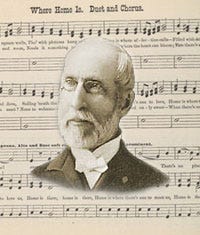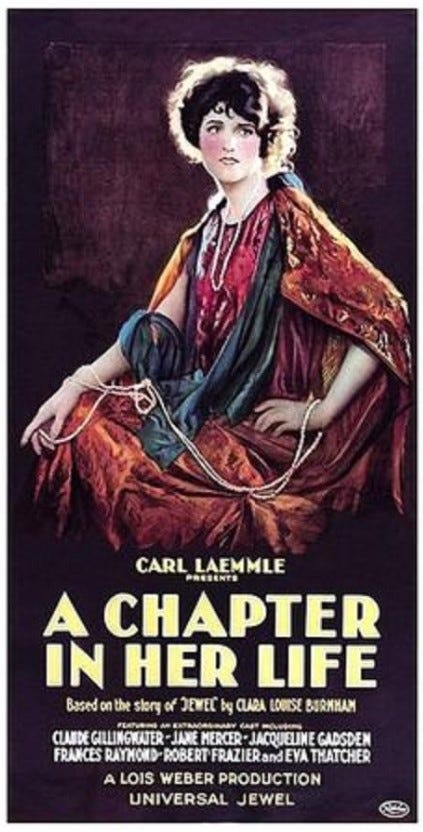I’m working on my next Herald article, rounding out features of Jackson Park with a look at the Golden Lady aka the Statue of the Republic replica. As a result, I thought I’d look at novels written in 1893 set at the Columbian Exposition to see what impression she made. Diaries tend to be laundry lists, but the novels talk about sensations and emotions.
One of the novels I stumbled into quite some time ago is Sweet Clover, a Romance of the White City. For a time, I volunteered to sit in the building for a couple of hours every Sunday. Almost no one came in, so I browsed the books and discovered Clover. Eventually, I wondered who Clara was. I was surprised to find out she was a life-long resident of Hyde Park and a nationally famous best-selling author.
Clara Louise Burnham, née Root
Clara’s family moved to Chicago when she was a child, soon after Paul Cornell convinced the Illinois Central Railroad to open a passenger station in the middle of nowhere. They seemed to have moved to Hyde Park soon after, and Clara spent the rest of her life watching the area change from sand ridges covered with wildflowers to a forest of tall hotels. The early settlers used to hold reunions in the 1920s to reminisce about the startling transformation. One of the things that struck me about Sweet Clover, is the characters’ lament that “their” Hyde Park was changing as the fair brought massive construction to the South Side.
Clara Burnham churned out at least 26 novels among her 42 published works from the 1880s to the 1920s, and I had never heard of her. I have a PhD in American literature and read a lot about the literary world of the late 19th century. I think part of the answer is that she wasn’t really in the literary world. The other part is of course that she was one of the “damned mob of scribbling women” that Nathaniel Hawthorne complained about decades earlier.
I wouldn’t say Sweet Clover is literature, though I recommend the characters’ descriptions of the fair. The plot barely has an outline and the characters, particularly the men, are two-dimensional. The Hyde Park Herald thought Clara’s earlier novels had clever plots, lifelike women, and feebly drawn men.
Maybe I should read one of her novels that Hollywood thought was worthy of the movies. Maybe Opened Shutters, described by the IMDB:
“When her indigent artist father dies, Sylvia Lacey goes to live with her Aunt Martha and her uncle, Judge Trent, in New England, where she is unwanted and humiliated. Though she and her uncle's young law partner John Dunham fall in love, she believes he intends to marry the daughter of a wealthy neighbor. Gradually Sylvia's charm and patience change her relatives' attitudes, and through her efforts, several conflicting branches of the family are reconciled. After John rescues Sylvia during a storm, she realizes his love for her.”
Another possibility is Jewel, which became a movie in 1919 and 1923:
“Jewel stays with her grizzled, angry grandfather while her parents are overseas on business. Family squabbling is brought to heel through love and understanding from Jewel's pure love for others and trust in Divine Love.”
I’m interested that the 1923 movie attracted a woman director, Lois Weber. Clara’s name appeared above the stars on the poster, so her fame lasted during her lifetime. She died in 1927 at the family cottage in Maine.
Thanks to the march of time, all of her novels are in the public domain, which means people have snatched them up, thrown a cover on, and posted them on Amazon for $1.99 on Kindle. Even before Amazon, someone had butchered Sweet Clover and reissued it. They cut out all of the beginning that establishes what plot there is, so the whole thing is even more of an inchoate mess than the original. People who buy that version on Amazon must be totally baffled if they were attracted by the impressionistic cover of a very explicit naked woman. The last thing any of Clara’s characters do is get naked.
Burnham was a Christian Scientist and three of her novels took that as a theme: The Right Princess, Jewel, and The Leaven of Love. There were two large stunningly beautiful Christian Scientist churches in Hyde Park so Clara was part of a large community. Her novels were praised by Mary Baker Eddy, the founder of Christian Science, who at first called Clara a “metaphysical surgeon.” Later, Eddy turned against the idea of romance. Eddy asked Burnham to change the endings so the romantic lead couple didn’t marry and finally said that Christian Science couldn’t endorse fiction in any form.
Weirdly, someone whose maiden name was Root and whose married name was Burnham was not, as far as I can tell, related to the great architects of the fair—Daniel Hudson Burnham and John Wellborn Root. She was the child of George Frederick Root. He too was very famous in his lifetime and barely remembered now.
George Frederick Root
George was was classically trained in Paris and Vienna and tried his hand at formal cantatas, but his renown came from dozens of popular songs. His brother Ebenezer had opened a music store with Chauncey M. Cady in downtown Chicago so George and his large family moved to Chicago in 1859 to join the enterprise. Root & Cady was the largest music store west of the East Coast, selling sheet music and musical instruments and providing lessons.
George Root moved to Hyde Park, where one of the junior partners, Henry Work, already lived. In Hyde Park, Work actually has a little fame because his cottage is the oldest structure in the neighborhood. It’s a kitchen attached behind a larger newer house at 5317 S. Dorchester. In reading his Wikipedia page, I realized I did know two of his songs: Marching through Georgia and My Grandfather’s Clock. My mother used to sing that after Dad bought a grandmother’s clock so a girl who came of age in the 1930s knew the lyrics.
Chicago and Hyde Park were filled with fervent supporters of Lincoln, abolition, and the Union cause and George’s triumphant years were the Civil War, when he apparently had 35 hits. His greatest fame came from two songs: Tramp, Tramp, Tramp, which Union soldiers used to sing while marching, and the rousing Battle Cry of Freedom, aka Rally ‘Round the Flag.

Like so many other enterprises, however, Root & Cady burnt to the ground in the Great Fire of 1871. They were bankrupt. Cady left Chicago and music, but the Root brothers and sons reopened a store, though it seems to have been a struggle, eased by Clara’s financial success.
Some Fame Lasts
Last week, Molly Gorman pointed out that some people are inescapably famous! Growing up in North Platte, Nebraska, Buffalo Bill’s birthplace, she was surrounded: “Buffalo Bill Rodeo, his home Scouts Rest Ranch, street… Fort Cody….”
https://outdoornebraska.gov/location/buffalo-bill-ranch/
Talk in November
Just a heads up that I’ll be giving a zoom talk on November 8 for the Hyde Park Village about how Hyde Park helped launch Frank Lloyd Wright. It’s a talk I gave in person last spring, but I wanted to zoom it because I think it’s a lot of fun with some insight into how Wright’s thinking developed. More info here:
https://chpv.org/content.aspx?page_id=4002&club_id=339585&item_id=2006926
Hyde Park Used Book Sale
And, if you are in Hyde Park, don’t forget this weekend—Saturday, Sunday, and Monday—there’s the Used Book Sale at the Hyde Park Shopping Center. I’ll be there fluffing books.








An interesting female writer I came across some years ago is Emily Kimbrough, who lived in Hyde Park as a young girl. I read her recollections of the area, but I don't remember what the book was called. There was an interesting essay of hers called "The Evening Train" that was featured once on an NPR show. It impressed me so much that I found it in the published collection of her essays. The co-authored "Our Hearts Were Young and Gay." I have her book of essays, which I will be happy to share with you if you like.
More very cool stuff!!